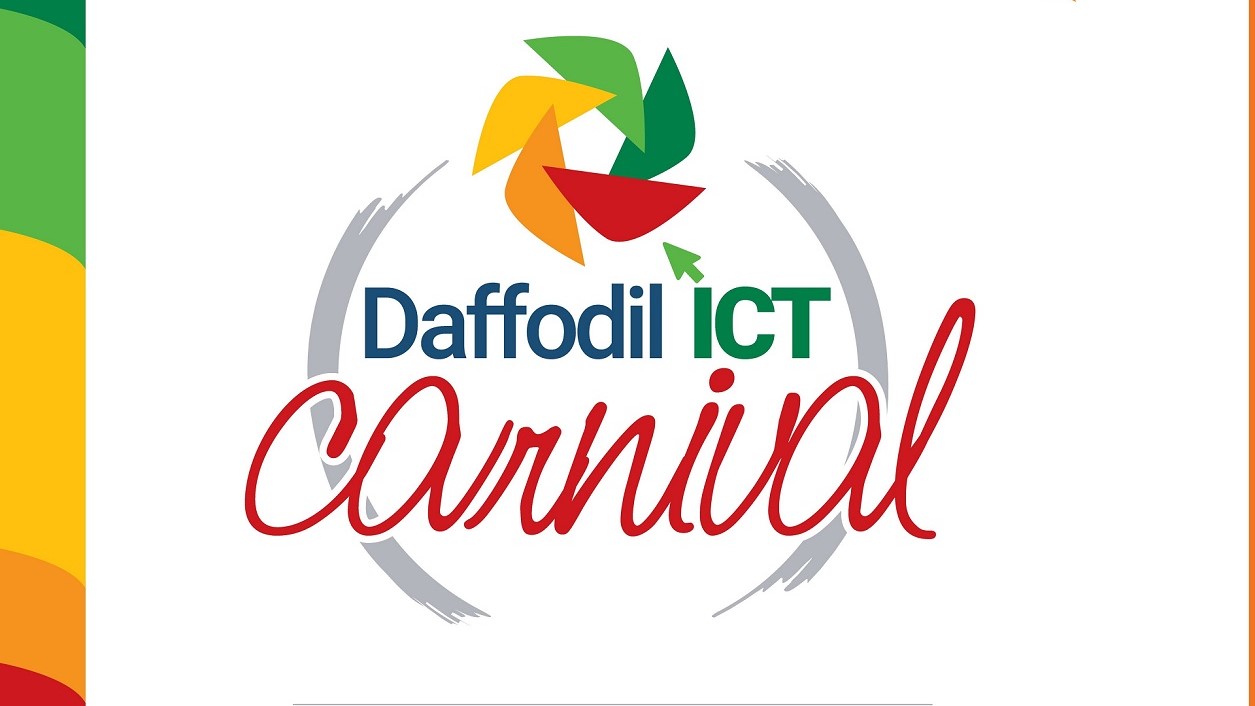Section outline
-
-
About ICT Carnival
ICT itself is in the craziest ride in terms of its fast development. A huge number of our young population is the passengers who are taking different benefits considering the latest trend and whatever opportunities are coming before them. In most cases, the talents are not explored for the absence of focus, exposure, link with industries. On the other hand, Industries don’t also get right talents which they need. To bridge between these two points and to showcase the products/services, Daffodil Family is going to organizing the ICT Carnival.
The objective of the festival is to bring all the talents, industry and opportunity on the same platform so that it gets success in true form. The event has been designed in such a way so that it gets a real festival mode. There are competitions, project showcase, counseling and mentoring, fun events, learning opportunity, networking scope and many more so that every moment of the fest can be enjoyed and utilized with adding value. The host is planning to organize it in an innovative, effective and broader way to bring the best outcome from it.
Objectives
To make a gradual change of course curriculum for adaptability
To set example and way out for students how to learn by doing
To show the strength of Daffodil in Technology
To develop system through mentor ship to ensure job
To enhance employ ability of the participants
To disseminate management’s vision among the students
To make an innovative learning platform for both teachers & students
To groom up students in a smart way
To generate and execute innovative ideas from the participants
To create some unique models by the participants
To make it a habit of a regular event of the respective departments
Target Group
Students of the Dept. of CSE, CIS, MCT, SWE, EEE of DIU, DIIT, DIA , Daffodil Family & DEN Concerns.
Faculty members of concerned departments
IT related organizations
-
-
-
Who can exhibit?
Projects, initiatives or organizations which receive or already have BVCL funding can apply, such as:
Advanced research projects;
Research, technology and innovation projects with high-tech prototype demonstrators;
Companies demonstrating innovative products that are on the market for less than 2 years;
Spin-off companies from BVCL funded projects;
ICT research and innovation stakeholders from around the world engaged in successful collaboration with partners.
Get Funding:
The start-up company or the candidates can take fund from BVCL
Who is the target audience?
Approximately 2000 visitors are expected to attend the ICT Carnival each year and will potentially visit the exhibition. Expected visitors of ICT Carnival are researchers, policy makers, innovators, businesses (including SMEs), start-ups, investors, strategists, students, etc.
Your exhibition Space
What will be provided to the exhibitors - for FREE?
(Indicative equipment; final set-up will be confirmed at a later stage)
- Exhibition – space & equipment
- 15 – 20 m² space
- Attractive and innovative labeling (visual ID + booth name)
- Screen 55' with remote control
- Cabled internet connection, wifi connection, electricity, spotlights
- Document rack: or alternative to display printed publications
- Table with 4 chairs
- Lockable counter with 2 high chairs
What will not be provided:
Supplementary Internet capacity (to be specified in your request);
Equipment costs (e.g. PCs, rental of specific equipment if needed) - you have to bring your own equipment;
Transportation costs for equipment;
Travel and accommodation costs for personnel (NB: stands must be staffed continuously during the three days of the exhibition; you must arrive the day before to set up the stand and must foresee time to dismantle the stand after the end of the event). Note that projects can include these costs in their cost statements through prior agreement with the Event Organizers
Insurance costs;
Any other costs associated with the stand.
Deadline for submission
(There will be specific deadline for submitting the projects which will be notified during the event circulation)
The deadline to submit your application is _________________
Successful applicants will be notified by end of _____________________
Venue
Daffodil Int. University, Ashulia Campus
Which are the themes of the exhibition?
You can choose from the following themes to exhibit your project:
"Inspiring a digital society"
"Creating networks and technology"
"Transforming industry and economy"
These themes are to be considered from a user perspective: Who will be the user group that benefits immediately from my project results? Is it the society at large? Will the project results contribute to further development of networks/technology/infrastructures? Will it contribute to a transformation or innovation of industry and economy?
How many themes can my project address?
You should choose one of the above themes for your project. You should justify your choice when filling in your application. If relevant, the project supervisors may move your project under another theme.
What do we expect from selected applicants?
Your booth/space should be visually appealing and creative so that it can attract the attention of all visitors, including the less technically savvy visitor. Interactive engagement with the public and display of prototypes are an asset.
Your booth/space should give the following information at a glance:
Which thematic area is covered by your project (e.g. HPC, robotics, eHealth, eGovernment)?
Which is the issue that the project is trying to solve and why is it important?
How are you trying to solve it?
What is your final goal?
Where exactly is your project now with reference to its final goal? Which level of maturity has it reached?
What are the next steps?
You should make sure that the booth/space displays and addresses the above-mentioned elements, so visitors can immediately see the project's goals and significance. You should be able to provide more in-depth information to specialized visitors like researchers, software specialists, etc., upon request.
Specific labels on some booths/spaces will draw the visitor's attention to a special outcome of a project e.g.
"market-ready", if your project has finalized a product which will be or has just been launched in the market;
"investor-ready", if your project is looking for investors for a specific item;
"spin-off", if your project has given rise to a spin-off company that wishes to benefit from ICT Carnival in making a new contact.
Each label will be subject to the Commission's approval.
Award criteria
The management will award exhibition spaces to projects which :
Propose promising research results,
Display these results in an appealing manner and
Are able to explain quickly and briefly on what issue they are solving, how they are solved and why it is important.
The attractiveness of the project demonstration and interactivity with visitors will be one of the highly ranked award criteria. You will also be challenged to show why your project merits to be funded, in which way its results are pioneering and how they bring added-value to the policies in the context of the Digital Single Market and the digitization.
The management reserves the right to select projects according to its individual evaluation but also in view of a balanced representation of areas. Some projects might be clustered in one bigger space.
-
-
-
For the students' project, there must be 02 project supervisors/managers in each team (one from DSL and one from Departmental Teacher). The Departmental/concern Head will select the project managers for each project.
The responsibilities of the supervisors are given below -
Market and Requirement Analysis
The core task of a project is to identify a product/service then analysis the market in respect of that product. Then reach to the different client for gathering the required points. Project managers have to play a vital role in market analysis and also for requirement analysis.
Planning Project Resources
A project can begin and certainly is designed to fail if there first wasn’t a plan devised to see it through, on time and within budget. The project manager’s first role is making a feasible plan that achieves the goals and objectives of the project and aligns with the organization’s overall business strategy. This is not only a blueprint with which to run the project but a critical part of the pitch to get approval for the project. Part of the plan is defining the project’s scope and determining what resources are available, estimating time and financial commitment, as well as how to monitor and report on the project’s progress.
Assembling and Leading Project Team
Project managers need resources to complete the project tasks, which includes skilled and experienced workers. They need to either take a leadership role with an existing team or create one. Once a team is created, you assign them tasks and deadlines, give them the tools to collaborate and don’t get in their way by micromanaging every activity. Meet regularly, of course, and get status updates to chart their progress while reallocating resources as needed to avoid blocking team members or overburdening them.
Time Management
Time is always ticking towards the project deadline. While communications are key to addresses changes and make sure everyone is doing what they need to do when they need to do it, the project manager must also define, schedule and accurately estimate the task duration to develop and maintain a realistic schedule.
Budget
Nothing is going to get done without money. Figuring out what the proper funding for the project is, having that get accepted and then keeping the project within or under that figure is often what makes or breaks a project. You can get your stakeholder their deliverable on time, but if that cost more than the budget you created, then the project is a failure. Making an accurate estimate is only the first part. Next, you must monitor the actual spend as compared to the planned budget. If those figures are off, you must adjust accordingly.
Quality and Satisfaction
These are two major hurdles to clear. You want to deliver to your stakeholders what they expected or better and make sure that they’re satisfied with the results. But that doesn’t mean ignoring them to focus solely on the project. Rather, you need to be in constant communications with them, reporting on progress and being open to their feedback to keep them happy and coming back to you with future projects.
Manage Issues and Risk
Problems will inevitably arise in a project. That’s called an issue. You need to be ready for them and work towards resolving them quickly, so as they don’t take your project off-track. Then there are risks, which are potential problems, ones that have yet to occur or might not ever. Regardless, you must figure out beforehand what the risks are and set in place a plan of action if they in fact occur.
Monitoring Progress
To make sure a project is progressing as planned, you must constantly measure it and compare those metrics against the plan you created. Therefore, you must have a way to collect project data, such as status reports from your team, to see if the actual progress of the project is meeting what you had initially planned. Things are going to change along the way, and you’re going to have to adjust or reallocate resources to accommodate these changes. If you’re not monitoring this, you’re managing in the dark.
Reporting and Documentation
Reporting is one of the ways you communicate with your team and stakeholders. While teams need more detailed information and stakeholders are looking for broader data to check the project’s progress, both are essential tasks for the project manager. This documentation, along with all paperwork, must be collected, signed off on and archived by the end of a project, which provides a history that you can revisit when planning for a similar project in the future.
-
-
-
Phase 01 - Requirement Analysis, Project Idea collection and selection
Responsible team: Faculty Supervisor & Software Team Supervisor
P 1.1 > Timeline > 01 Month
Requirement Analysis by supervisors
Architecture design with DSL along with project Supervisor
Share the project requirements among the students
Independent Idea collection from Students
P 1.2 > Timeline > 02 Month
Project Demo presentation by students
Get Project Approval from supervisors
Get Prepared for Final Project after approval of the supervisors
P 1.3 > Timeline > 02 Month
Demonstrate the followings -
Project Documentation
SRS
Project Proposal
Project Video
Phase 02 - Project Selection for Final Round
Responsible team: Departmental Heads, Faculty Supervisor & Software Team SupervisorP 2.1 > Timeline > 01 Month
Selection of the final Projects which will be showcase in final round
P 2.2 > Timeline > 01 Month
Department wise project demonstration
Guidelines to the selected Projects by supervisors
Phase 03 - Final Project Selection & Award
Responsible team: Departmental Heads, Faculty Supervisor, Software Team Supervisor & Management committeeP 3.1 > Timeline > 01 Month
All final project observation by supervisors , technical persons and management for screening
Final Submission of -
Project Documentation
SRS
Proposal
P 3.2 > Timeline > 02 Month
Final Project handover -
Software Architecture design
Source Code
Database design
Related materials
P 3.3 > Timeline > 02 Day
Final Project Showcase in ICT Carnival 2019
P 3.4 > Timeline > 01 Day
Result Publish & Award Giving Day – All the selected projects will be awarded
-
-
-
Project Categories
- Healthcare Solution
- Education Solution
- Business Solution
- E-Commerce
- Workplace
- ICT Solution
- IOT Solution
- Robotics Project
- Mobile App Development like Uber, Pathao, Sheba.xyz, daraz etc.
- Independent project with innovative idea
-
-
-
Project Title
Write a clear, brief title that helps people quickly understand the gist of your project.
Project Description
Describe what you're planning to do, why you care about it, how you plan to make it happen, and who you are. Your description should tell backers everything they need to know. If possible, include images to show them what your project is all about and what rewards look like. Describe your projects technical points -
- Software Framework
- Software Version
Personal/Team Profile
This will appear on your project page and must include your/Team members’ name, photo, and biography.
- Add Resume
- Add Google Site
- Add video resume
- Other Information
Project Category
Choose the category that most closely aligns with your project.
As per the study of Daffodil Family the categories are –
- · Healthcare Solution
- · Education Solution
- · Business Solution
- · E-Commerce
- · Workplace
- · ICT Solution
- · IOT Solution
- · Robotics Project
- · Mobile App Development
- · Independent project with innovative idea
Add Project Images & Videos:
Add an image that clearly represents your project.
- · Add Poster or banner of your Project
- · Add functional screen capture images of your project
Add a video that describes your project.
- · Add a promo video
- · Add functional video of your project
Project Features
- · Summary of what you are making
- · Add all the features of your projects
- · Project Framework and versions
- · Used Technology
Project Documents
Submit the following documents of your project -
- · Approved Business Requirement documents (BRD)
- · Technical requirements
- · Software Security, Availability & Accessibility Requirements
- · User Manual
- · Source code
- · Software requirements specification (SRS)
- · Domain-driven design (DDD)
- · Data flow diagram (DFD)
- · Entity relationship diagram (ERD)
- · Interface requirements with other systems
- · System Operating Procedure (SOP)
- · Software Test Report - Functionality (Unit + Integrity), Security (Unit + Integrity), User Acceptance (Operational), User Verification (Operational), Others as per need or your choice
Benefits, Risks and Challenges
- · Add the Benefits of your projects.
- · Be honest about the potential risks and challenges of this project and how you plan to overcome them to complete it.
-
-



